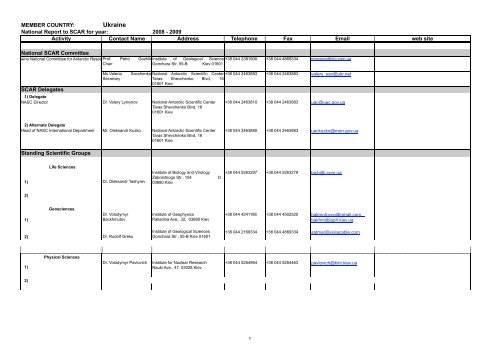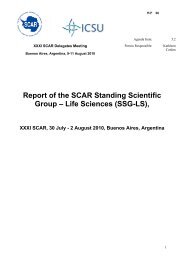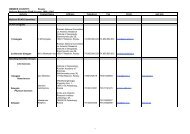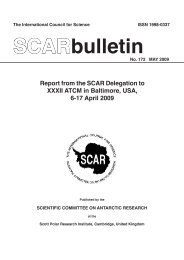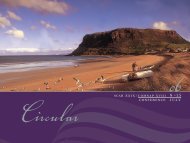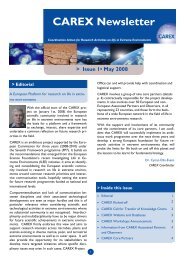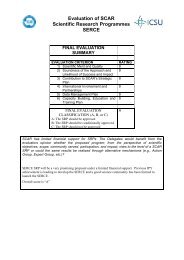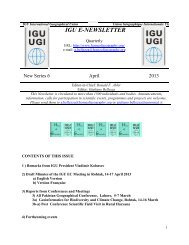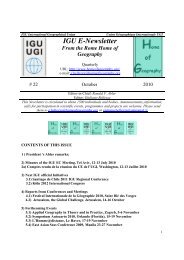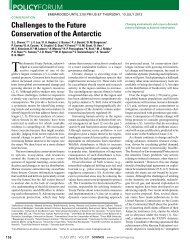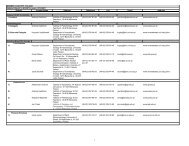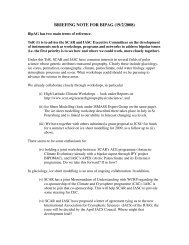Ukraine - Scientific Committee on Antarctic Research
Ukraine - Scientific Committee on Antarctic Research
Ukraine - Scientific Committee on Antarctic Research
Create successful ePaper yourself
Turn your PDF publications into a flip-book with our unique Google optimized e-Paper software.
MEMBER COUNTRY: <str<strong>on</strong>g>Ukraine</str<strong>on</strong>g><br />
Nati<strong>on</strong>al Report to SCAR for year: 2008 - 2009<br />
Activity C<strong>on</strong>tact Name Address Teleph<strong>on</strong>e Fax Email web site<br />
Nati<strong>on</strong>al SCAR <str<strong>on</strong>g>Committee</str<strong>on</strong>g><br />
<str<strong>on</strong>g>Ukraine</str<strong>on</strong>g> Nati<strong>on</strong>al <str<strong>on</strong>g>Committee</str<strong>on</strong>g> for <strong>Antarctic</strong> <strong>Research</strong> Prof. Petro Gozhik Institute of Geological Science +38 044 2381900 +38 044 4869334 mmcgeo@nbi.com.ua<br />
Chair<br />
G<strong>on</strong>chara Str, 55-B Kiev 01601<br />
SCAR Delegates<br />
Ms.Valeria<br />
Secretary<br />
1) Delegate<br />
NASC Director Dr. Valery Lytvynov Nati<strong>on</strong>al <strong>Antarctic</strong> <str<strong>on</strong>g>Scientific</str<strong>on</strong>g> Center<br />
Taras Shevchenko Blvd, 16<br />
01601 Kiev<br />
Savchenko Nati<strong>on</strong>al <strong>Antarctic</strong> <str<strong>on</strong>g>Scientific</str<strong>on</strong>g> Center +38 044 2463883 +38 044 2463883 valery_sav@ukr.net<br />
Taras Shevchenko Blvd, 16<br />
01601 Kiev<br />
+38 044 2463810 +38 044 2463883 uac@uac.gov.ua<br />
2) Alternate Delegate<br />
Head of NASC Internati<strong>on</strong>al Department Mr. Oleksandr Kuzko Nati<strong>on</strong>al <strong>Antarctic</strong> <str<strong>on</strong>g>Scientific</str<strong>on</strong>g> Center<br />
Taras Shevchenko Blvd, 16<br />
01601 Kiev<br />
+38 044 2463880 +38 044 2463883 uackuzko@m<strong>on</strong>.gov.ua<br />
Standing <str<strong>on</strong>g>Scientific</str<strong>on</strong>g> Groups<br />
Life Sciences<br />
1) Dr. Oleksandr Tashyrev<br />
Institute of Biology and Virology<br />
Zabolotnogo Str., 154<br />
03680 Kiev<br />
D<br />
+38 044 5263297 +38 044 5263279 tach@i.com.ua<br />
2)<br />
1)<br />
Geosciences<br />
Dr. Volodymyr<br />
Backhmutov<br />
Institute of Geophysics<br />
Palladina Ave., 32, 03680 Kiev<br />
+38 044 4241186 +38 044 4502520 bakmutovvg@gmail.com<br />
bakhm@igph.kiev.ua<br />
2) Dr. Rudolf Greku<br />
Institute of Geological Sciences<br />
G<strong>on</strong>chara Str., 55-B Kiev 01601<br />
+38 044 2169334 +38 044 4869334 satmar@voliacable.com<br />
1)<br />
Physical Sciences<br />
Dr. Volodymyr Pavlovich<br />
Institute for Nuclear <strong>Research</strong><br />
Nauki Ave., 47, 03028 Kiev<br />
+38 044 5254964 +38 044 5254463 pavlovich@kinr.kiev.ua<br />
2)<br />
1
Activity C<strong>on</strong>tact Name Address Teleph<strong>on</strong>e Fax Email web site<br />
<str<strong>on</strong>g>Scientific</str<strong>on</strong>g> <strong>Research</strong> Program<br />
1)<br />
2)<br />
3)<br />
4)<br />
ACE<br />
AGCS<br />
1) Dr.Vazira Martazinova<br />
2)<br />
3)<br />
4)<br />
EBA<br />
1) Dr. Oleksandr Tashyrev<br />
2)<br />
3)<br />
4)<br />
1)<br />
2)<br />
3)<br />
4)<br />
1)<br />
2)<br />
3)<br />
4)<br />
ICESTAR<br />
SALE<br />
Institute of Hydromeorology, Nauki<br />
Ave., 37, 03650 Kiev<br />
+38 044 5258790<br />
+38 044 5255363<br />
Institute of Biology and Virology<br />
Zabolotnogo Str., 154<br />
D<br />
03680 Kiev +38 044 5263279 +38 044 5263279<br />
nigmi2@yandex.ru<br />
vazira@gmail.com<br />
tach@i.com.ua<br />
tach2007@ukr.net<br />
2
Activity C<strong>on</strong>tact Name Address Teleph<strong>on</strong>e Fax Email web site<br />
ACTION GROUPS<br />
1) Predicti<strong>on</strong> of Changes in the Physical<br />
and Biological Envir<strong>on</strong>ment of the <strong>Antarctic</strong><br />
2)<br />
3)<br />
4)<br />
insert others as needed<br />
Dr. Oleksandr Tashyrev<br />
Institute of Biology and Virology<br />
Zabolotnogo Str., 154<br />
D<br />
03680 Kiev +38 044 5263279 +38 044 5263279<br />
tach@i.com.ua<br />
tach2007@ukr.net<br />
STANDING COMMITTEE<br />
1) <strong>Antarctic</strong> Geografic Informati<strong>on</strong> Dr. Andriy Fedchuk Nati<strong>on</strong>al <strong>Antarctic</strong> <str<strong>on</strong>g>Scientific</str<strong>on</strong>g> Center<br />
Taras Shevchenko Blvd, 16<br />
01601 Kiev<br />
+38 044 2463883 +38 044 2463883 andriyf@gmail.com<br />
JCADM<br />
1) Dr. Nikolay Sidorov Nati<strong>on</strong>al Aviati<strong>on</strong> University<br />
Komarova Ave., 1 03058 Kiev<br />
+38 044 4067396 +38 044 4067396<br />
nikolay.sidorov@livenau.net<br />
NATIONAL ANTARCTIC DATA CENTRE<br />
Nati<strong>on</strong>al <strong>Antarctic</strong> <str<strong>on</strong>g>Scientific</str<strong>on</strong>g> Center Mr. Mykola Le<strong>on</strong>ov Nati<strong>on</strong>al <strong>Antarctic</strong> <str<strong>on</strong>g>Scientific</str<strong>on</strong>g> Center +38 044 2463880 +38 044 2463880 uac@uac.gov.ua<br />
Taras Shevchenko Blvd, 16<br />
01601 Kiev<br />
3
A BRIEF SUMMARY OF SCIENTIFIC HIGHLIGHTS:<br />
Geological research<br />
Electr<strong>on</strong>ic Atlas of the <strong>Antarctic</strong> deep structure according to the gravimetric tomography data was created. The Atlas c<strong>on</strong>tains informati<strong>on</strong> <strong>on</strong> anomalous density heterogeneities derived by<br />
gravimetric tomography method using EGM96 gloval gravity potential model (geoid). The 3D images of the <strong>Antarctic</strong> lithosphere are shown by vertical cross-secti<strong>on</strong>s and lateral slices <strong>on</strong><br />
different depths within the area of 30°S. Techt<strong>on</strong>ic seting, intraplate and interplate processes in the <strong>Antarctic</strong> regi<strong>on</strong> are shown <strong>on</strong> both the global maps and the cross-secti<strong>on</strong>s al<strong>on</strong>g the<br />
<strong>Antarctic</strong> Plate's boundary by spreading the mid-ocean ridges <strong>on</strong> more than 40,000 km. The primary c<strong>on</strong>necti<strong>on</strong> of the mantle plume below the Ross Sea area with the North America soft<br />
mantle domain is destinguished at a depth of 5300 km. New informati<strong>on</strong> <strong>on</strong> propagati<strong>on</strong> of hot material of the Ross plume into the cold oceanic lithosphere was obtained in the Australian-<br />
<strong>Antarctic</strong> Discordance and the Nazca Ridge <strong>on</strong> several vertical secti<strong>on</strong>s. Regi<strong>on</strong>al features of the deep structure within the area of Scotia Sea and within the both Pacific and <strong>Antarctic</strong><br />
mantle upwelling are shown al<strong>on</strong>g the 58°S. The pathways for moving the mantle substance fr<strong>on</strong> the Weddel subducti<strong>on</strong> z<strong>on</strong>e to the Bransfield Rift system are revealed. The pathways of<br />
uprising of soft mantle material in the West <strong>Antarctic</strong> Rift System are also shown al<strong>on</strong>g the meridians 90°W and 170°W.<br />
Atlas includes 61 maps and secti<strong>on</strong>s and following topics: Gravimetric Tomography Method and initial data; Interacti<strong>on</strong> of <strong>Antarctic</strong>a with other regi<strong>on</strong>s; Modificati<strong>on</strong> of the Earth's structure<br />
<strong>on</strong> different depths within the <strong>Antarctic</strong> lithosphere plate; Deep structure of the <strong>Antarctic</strong> Plate's boundary z<strong>on</strong>e; Trans <strong>Antarctic</strong> vertical secti<strong>on</strong>s; Cross-secti<strong>on</strong>s of Western <strong>Antarctic</strong>a;<br />
Detailed structure maps of the West <strong>Antarctic</strong>a; Large-scale structurel features of the Scotia Plate.<br />
The geoinformative system today are the equate means of support of geologists' activity with the factual providing and inquiry service functi<strong>on</strong>. GIS-technologies applicati<strong>on</strong> for treatment<br />
of magnetometer survey materials in the water area nearby Vernadsky stati<strong>on</strong> allowed attaining some success. As a result of measuring during the three field seas<strong>on</strong>s the database had<br />
been obtained. The database includes measurements of complete field vector module in more than 40000 points. The closeness of profiles and amounts of measurements varies str<strong>on</strong>gly<br />
from seas<strong>on</strong> to seas<strong>on</strong>. While trasferring the data to the platform, GIS materials were presented and analyzed <strong>on</strong> each level. After that the four seas<strong>on</strong>s' data were linked to form the<br />
integrated data array.<br />
Meteorological research<br />
The developed in 1998 method of l<strong>on</strong>g-range weather forecast for the moderate latitudes of Nothern hemisphere is based <strong>on</strong> two-m<strong>on</strong>th similarity of atmospheric circulati<strong>on</strong> which is well<br />
revealed by the traditi<strong>on</strong>al method of analogues of <strong>on</strong>e seas<strong>on</strong>. That is why the similarity of atmospheric processes in the n<strong>on</strong>-tropical latitudes of Southern hemisphere was also studied<br />
by the method of traditi<strong>on</strong>al analogue. Taking into account the found out period of quasi-periodicity of regi<strong>on</strong>al atmospheric circulati<strong>on</strong> of the <strong>Antarctic</strong> Peninsula about 60 days in summer<br />
and about 70 days in winter the forecast scheme of anomaly of mean m<strong>on</strong>thly temperature of air is developed. The forecast scheme of anomaly of average m<strong>on</strong>thly air temperature for the<br />
area of Vernadsky Stati<strong>on</strong> is developed with m<strong>on</strong>thly earliness using the equati<strong>on</strong>s of linear regressi<strong>on</strong>. The anomaly of mean m<strong>on</strong>th air temperature of initial m<strong>on</strong>th is used in equati<strong>on</strong> of<br />
linear regressi<strong>on</strong> as predictor. the verificati<strong>on</strong> of forecast scheme was carried out <strong>on</strong> dependent material of several years and showed success of the offered method of forecast of average<br />
m<strong>on</strong>thly air temperature for Vernadsky Stati<strong>on</strong>. For the improvement of estimati<strong>on</strong>of extreme values of temperature <strong>on</strong> the <strong>Antarctic</strong> Peninsula and at Vernadsky Stati<strong>on</strong> the scheme of l<strong>on</strong>grange<br />
forecast of mean m<strong>on</strong>thly air temperature was complemented by auxiliary equati<strong>on</strong>s which allow calculating extreme values. On the whole, it is possible to note that the found out<br />
atmospheric circulati<strong>on</strong> c<strong>on</strong>formities of near two-m<strong>on</strong>th quasi-periodicity for the moderate latitudes of Southern hemisphere can be basis for development of method of l<strong>on</strong>g-range forecast<br />
of atmospheric circulati<strong>on</strong> and weather c<strong>on</strong>diti<strong>on</strong>s for the <strong>Antarctic</strong> C<strong>on</strong>tinent.<br />
Geophysical research<br />
The most informative geophysical method to study the Earth's deep structure is assumed to be seismic tomography. For the study regi<strong>on</strong> we use seismic tomography method based <strong>on</strong><br />
Backhus-Gilbert approximati<strong>on</strong> using the data <strong>on</strong> earthquake hipocentre and time arrival of P-waves recorded by network of seismic stati<strong>on</strong>s. The seismology data are taken from<br />
catalogues of Internati<strong>on</strong>al Seismology Center (ISC), from informati<strong>on</strong> of IRIS Corporati<strong>on</strong> (Incorporated <strong>Research</strong> Instituti<strong>on</strong>s for Seismology) data of Geological Survey of USA and data<br />
coming from AIA seismic stati<strong>on</strong> mounted at the Ukrainian Vernadsky Stati<strong>on</strong>. The earthquake catalog of the regi<strong>on</strong> c<strong>on</strong>tains events with magnitude M≥5.<br />
4
Oceanographic research<br />
<strong>Research</strong> results of the seas<strong>on</strong>al and interannual sea ice variability of different closeness around the <strong>Antarctic</strong> C<strong>on</strong>tinent are submitted. Correlati<strong>on</strong> between variability of the atmospheric<br />
circulati<strong>on</strong> indexes South Oscillati<strong>on</strong> (SOI) and <strong>Antarctic</strong> Oscillati<strong>on</strong> (AAO) and ice c<strong>on</strong>diti<strong>on</strong>s are analyzed. Their c<strong>on</strong>necti<strong>on</strong> with the air temperature at polar stati<strong>on</strong>s in the <strong>Antarctic</strong><br />
Peninsula Regi<strong>on</strong> is c<strong>on</strong>sidered. The data of sea ice closeness <strong>on</strong> 1°x1° grid from array British Atmospheric Data Centre HadISST ICE are used. It is shown that the seas<strong>on</strong>al<br />
variability of the ice closeness is most pr<strong>on</strong>ounced in the Weddel, Lazarev, Sodruzhestvo Seas. The areas of maximal seas<strong>on</strong>al variability of the sea ice closeness are<br />
extended in east directi<strong>on</strong> al<strong>on</strong>g movement of the <strong>Antarctic</strong> Circumpolar current waters. The minimal seas<strong>on</strong>al variability of the sea ice closeness is observed in the<br />
Anatrctic costal areas, where the extensive ice shelves (Larsen, R<strong>on</strong>ne, Filchner, Ross and Abbot) are located. It is fouded that the closest correlati<strong>on</strong> berween the SOI<br />
and the sea ice closeness era observed in the areas of their maximum interannual variability: direct correlati<strong>on</strong> (RSOI ~ 0,6) in the area between 130-150 W and 63-70S, inverse<br />
correlati<strong>on</strong> (Rsoi ~ ?0,6) in the Weddel Sea. Significant correlati<strong>on</strong> between the index AAO and the sea closeness (RAAO ~ -0,6) is founded to west from the <strong>Antarctic</strong> Peninsula. The close<br />
inverse correlati<strong>on</strong> (-0,6 ...-0,8) between the air temperature at Vernadsky, Bellinsghausen, Rothera, Orcadas, Marambio polar stati<strong>on</strong>s and sea ice closeness in the regi<strong>on</strong> of Vernadsky<br />
stati<strong>on</strong> is obtained.<br />
Medical research<br />
In extreme c<strong>on</strong>diti<strong>on</strong>s the support of a normal working rhythm of a pers<strong>on</strong> requires mobilizati<strong>on</strong> of additi<strong>on</strong>al reserves of a body, especially in c<strong>on</strong>diti<strong>on</strong>s of l<strong>on</strong>g-term social isolati<strong>on</strong> of a<br />
small collective. In such c<strong>on</strong>diti<strong>on</strong>s of incomplete renewal of the body functi<strong>on</strong>al state <strong>on</strong> the background of desynchr<strong>on</strong>ous phenomena, the development of pre-parthological functi<strong>on</strong>al<br />
states of overstrain can occur, which can be the basis for disadaptati<strong>on</strong> development. The functi<strong>on</strong>al state of the central nervous system (CNS) was estimated <strong>on</strong> departure to the<br />
Vernadsky Stati<strong>on</strong> and after returning from the wintering using EEG standard methods. It was revealed that at the end of wintering in the structure of bioelectric activity of the brain cortex<br />
significant changes were recorded in the delta range (the capacity increased by 5,6%) and in the alpha range (the capacity decreased by 9,5%). Almost the total decrease of alpha activity<br />
(except for the left perietal part) in the right hemisphere wes recorded. Thus, over the period of wintering significant changes in the bioelectric activity point to noticeable involvement of the<br />
right hemisphere, which is resp<strong>on</strong>sible for specifically creative thinking and emoti<strong>on</strong>al activity. The received data <strong>on</strong> the brain bioelectric activity, <strong>on</strong> the whole, can point to the adaptive<br />
decrease of the functi<strong>on</strong>al state of the CNS <strong>on</strong> the background of the great activati<strong>on</strong> of the sympathetic department of the vegetative nervous system in c<strong>on</strong>diti<strong>on</strong>s of the chr<strong>on</strong>ic stress in<br />
the <strong>Antarctic</strong> regi<strong>on</strong>.<br />
Biotechnologies<br />
The biogeographical polyg<strong>on</strong> with the maximal diversity of biotopes is developed in the <strong>Antarctic</strong> oasis <strong>on</strong> Galindez Island. With the help of GPS and GІS - methods the 3D model and a<br />
topographical map of polyg<strong>on</strong> is c<strong>on</strong>structed. Geochemical researches <strong>on</strong> studying the c<strong>on</strong>tents of 19 elements (metals and n<strong>on</strong>metals) in sediments (soil, humus, lake sediments), the<br />
molecular-mass characteristic of humic acids of <strong>Antarctic</strong> soils are carried out. System researches of physiological groups of soil microorganisms of the polyg<strong>on</strong> are carried out. Correlati<strong>on</strong><br />
factors between number and distributi<strong>on</strong> of physiological groups of microorganisms and the c<strong>on</strong>tents of humic-like substances in soils are determined. The microbiological counts of<br />
psychrotolerant and mesophyllic microorganisms which are characterized as oligotrophic, autochth<strong>on</strong>ic and zymogenic are carried out. It is established, that they are primary factors of<br />
humus and soil formati<strong>on</strong> and provide circulati<strong>on</strong> of elements. Quantitative parameters of a homeostasis of microbial populati<strong>on</strong>s under influence of a raising gradient toxic Cu2 + are<br />
received.<br />
Complex biogeographical researches of a z<strong>on</strong>e of Penola Passage are carried out: 60 km from the north to the south (Booth - Lippmann Islands) and 30 km from the West to the east<br />
(Cruls Islands - Tuxen Cape). The large-scale microbiological analysis of biotopes (265 samples of soil, mosses, lichens, lake sediments, water, humus) <strong>on</strong> 19 islands and capes of the<br />
c<strong>on</strong>tinent is carried out. In a z<strong>on</strong>e methylotrophic bacteria are widely occurred. They play an important role in transformati<strong>on</strong> of methanol in a global biogeochemical cycle of carb<strong>on</strong> and<br />
positively influence flora of <strong>Antarctic</strong> Regi<strong>on</strong> due to phytosymbiosis. As a result of system researches the presence of the basic phylum prokaryotes and eukaryotes is revealed: bacteria<br />
(Proteobacteria, Firmicutes, Actinobacteria), yeast (Ascomycota) and microscopic fungi (Basidiomycota). In biotopes with high level UV-radiati<strong>on</strong> (vertical rocks) dominate pigmentproducing<br />
strains which are producers of biologically active substances: melanins, phytohorm<strong>on</strong>es, carotenes, etc. Antibiotic-producing (Pseudom<strong>on</strong>as) and melanin-producing strains with<br />
anticarcinogenic and antiulcerogenic properties (Exophiala nigra) are isolated.<br />
5
For the first time it is shown, that resistance of chemoorganotrophic microorganisms to very high c<strong>on</strong>centrati<strong>on</strong> of toxic metals is the widespread biological phenomen<strong>on</strong> <strong>on</strong> an internal<br />
island shelf and the western coast of <strong>Antarctic</strong> peninsula. The <strong>Antarctic</strong> microorganisms are resistant to a wide spectrum of the most toxic metals (Hg2+, Cu2+, Cd2+ Co2+, Сr(VI), Ni2+)<br />
in a range 500-1000 ppm. Metal resistant microorganisms are present at all terrestrial biotopes (humus, soil, rocky breeds, lake sediments, lichens, mosses, vascular plants). The number<br />
of metal resistant microorganisms is 1-5 % of their total amount and makes 103...106 col<strong>on</strong>y forming units/g of sample. The collecti<strong>on</strong> (60 strains) of metal resistant microorganisms is<br />
created. Ten strains are polyresistant to high c<strong>on</strong>centrati<strong>on</strong> of the most toxic metals (in ppm): Hg2+ and Cd2+-500, Co2+-1000, Ni2+-2000, Cu2+-3000, Сr(VI)-60000. The database of a<br />
biogeographical z<strong>on</strong>e (30×60 km) and series of 3D-models of polyg<strong>on</strong>, developed by GIS and GPS methods, include c<strong>on</strong>centrati<strong>on</strong> of elements specified in stati<strong>on</strong>ary sampling points<br />
(including toxic metals) and number of physiological groups microorganisms of biogeochemical cycles of elements (including metal resistant). It is proved that metal resistance has a<br />
plasmid origin. The system of quantitative criteria of resistance of microorganisms to toxic metals is developed. On the basis of the <strong>Antarctic</strong> microorganisms which effectively accumulate<br />
toxic metals, universal nature protecti<strong>on</strong> biotechnologies of sewage treatment from a wide spectrum of metals in any c<strong>on</strong>centrati<strong>on</strong> range will be developed.<br />
The complex geoinformati<strong>on</strong> system database, which characterizes structural and functi<strong>on</strong>al c<strong>on</strong>necti<strong>on</strong>s in microbial communities of typical biotopes of <strong>Antarctic</strong> Regi<strong>on</strong> in a z<strong>on</strong>e (30×60<br />
km) of island shelf of passage Penola of the western coast of <strong>Antarctic</strong> peninsula, is developed.<br />
Physical research<br />
The regi<strong>on</strong> of <strong>Antarctic</strong> Peninsula seems to be an ideal area for investigating the troposphere-to-i<strong>on</strong>osphere energy transfer as it combines the extremely high cycl<strong>on</strong>e activity with a quiet<br />
mid-latitude i<strong>on</strong>ospheric background. Atmospheric gravity waves (AGW) are the principal transportati<strong>on</strong> agent. Using the data of l<strong>on</strong>g- term measurements, there were detected coupling<br />
effects of quasi-periodical variati<strong>on</strong>s in atmospheric pressure with geomagnetic field variati<strong>on</strong>s (period about 90 minutes) both at Vernadsky Stati<strong>on</strong> and the magnetic-c<strong>on</strong>jugate regi<strong>on</strong>.<br />
The typical delay time between local variati<strong>on</strong>s of preassure and magnetic field (30 minutes) corresp<strong>on</strong>ds to the AGW propagati<strong>on</strong> lag toward the dynamo area. Also sporadic E-layers and<br />
spread-F are observed more frequently above the atmospheric fr<strong>on</strong>ts in winter. The intensified troposphere-i<strong>on</strong>osphere interacti<strong>on</strong> is increased with reducti<strong>on</strong> of warm-up of the<br />
oz<strong>on</strong>osphere in winter or with oz<strong>on</strong>e hole developing. This leads to the increase of the Brunt-Vaissala frequency in mesosphere, improving c<strong>on</strong>diti<strong>on</strong>s for vertical AGW propagati<strong>on</strong>.<br />
6


